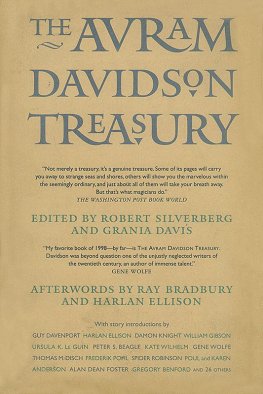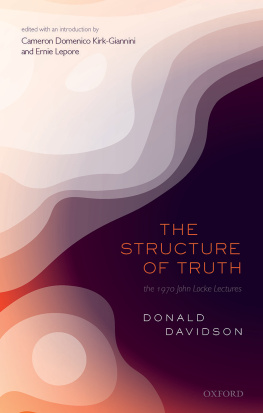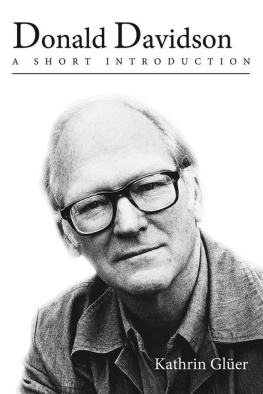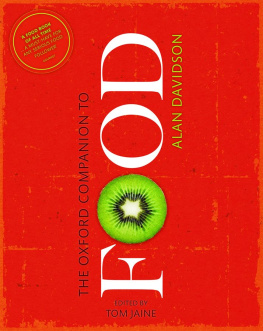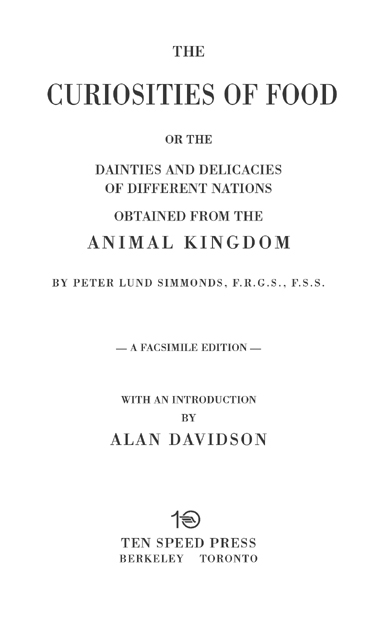Introduction 2001 by Alan Davidson.
The original edition was first published in 1859 by Richard Bentley,
London. First Ten Speed Press edition, 2001
The publisher wishes to thank both Alan Davidson for his loan of the original edition of The Curiosities of Food for reproduction purposes, and the staff of the Bioscience Library at the University of California, Berkeley, for their research assistance.
All rights reserved. No part of this book may be reproduced in any form, except brief excerpts for the purpose of review, without written permission of the publisher.

Ten Speed Press
P.O. Box 7123, Berkeley, California 94707
www.tenspeed.com
Distributed in Australia by Simon and Schuster Australia, in Canada by Ten Speed Press Canada, in New Zealand by Southern Publishers Group, in South Africa by Real Books, in Southeast Asia by Berkeley Books, and in the United Kingdom and Europe by Airlift Book Company.
Library of Congress Cataloging-in-Publication Data
Simmonds, P. L. (Peter Lund), 18141897.
The curiosities of food: or, the dainties and delicacies of different nations obtained from the animal kingdom / Peter Lund Simmonds.Facsimile ed. / with an introd. by Alan Davidson.
p.cm.
Originally published: London : R.Bentley, 1859.
1. Food I. Title.
TX355.S59 2001
641.3dc21
2001027323
eISBN: 978-0-307-81409-8
v3.1
INTRODUCTION
Close to the Thames and behind Londons Victoria Station (gateway to the continent as it has proclaimed itself for a hundred years) lies Pimlico, a Victorian development of terraced houses, set along wide, sedate streets. The houses, originally intended for moderately prosperous middle class citizens of London, who would have had staff to cook in the basement kitchen and cope with the gas lighting and numerous coal fires, are now mostly split up into small apartments, with inhabitants very different from the original occupiers. Yet from outside they look much the same as in the 1850s, when Peter Lund Simmonds, author of this book, resided at number 8 Winchester Street. One may guess that he did his writing on the first floor, with a fine view of the street, and the passing carriages and pedestrians, from the tall front windows and a large library in the room behind, overlooking the small garden with which each house in the terrace was blessed. Living in a closely similar house only a mile and a quarter away, I can readily imagine the scene.
On the front of the house there is no circular blue plaque, such as adorns numerous London houses that were once inhabited by the famousCanaletto, say, or Mozart, or George Eliot. Perhaps this will be put right one day. I think that it should be. Simmonds deserves posthumous fame for a great pioneering feat; he was the first person to compose a serious global study of what foods have been eaten, and where, by human beings.
There had since antiquity been a number of studies of foods of the known world (the Near East, the Mediterranean, and Europe), notably those of classical and medieval times that were essentially concerned with health and reflected the current Doctrine of the Four Humours. Their aim was to show how all the various foodstuffs could be classified as hot or cold. One late example that I treasure is the Diaeteticon of Nonnius (1646). But the scope of all these compilations was narrow, and their focus was medical and nutritional. They had no social or ethnic content and hardly any geographical background. Strange foods eaten in faraway places by strange peoples had no place in them. Even Louis Lemery (sometimes spelled Lmery), the Frenchman whose Trait des Alimens (1702, translated into English 1704 and 1745) was broader in scope, wrote in and for Europe. Other continents had by now been discovered and partly explored, but he made only occasional and scant references to Asia and the New World, giving no space to edibles that were unknown in the culture to which he belonged. (Where at that time would he have found the information?)
The 19th century, I believe, afforded the first opportunity to examine food in a global perspective, past and present, and to do this in a dispassionate way, recording rather than recommending or condemning. In short, it was a fine time for Simmonds to embark on this new venture. Travel writings, covering virtually the whole globe, had been proliferating, and they included many detailed accounts of eating habits. Simmonds evidently devoured these with as much relish as his Bechuanas devoured elephant fat; and he acknowledged his variegated sources punctiliously. (I am now in search of an early issue of Scientific American which, he says, provides evidence of leeches, both marine and freshwater, being eaten in China and Japan.)
Simmonds certainly was, as the obituary notice in the Times (6 October 1897) pointed out, a voluminous writer and a most laborious and industrious worker. There cannot be many people who have read all his writings. I am not one of these, but I have acquired and studied several of his other major works and think I can say with confidence that The Curiosities of Food is the most readable of his books and the one of most enduring interest. Unlike what was, in his lifetime, his best-known book (Waste Products and Undeveloped Substances, 1862), it deals with a subject whose contours change little as the centuries roll by. Radical changes in diet and eating habits occur slowly, and groups of human beings are perennially surprisedsometimes horrifiedto hear about what they regard as the strange foods of other groups.
This interest in what others eat can be traced back a long way; witness observations in classical times by such authors as Herodotus and Aelian. These classical allusions were no doubt familiar to Simmonds, whose own writings display a knowledge of classical works and a command of other languages that were typical of English writers of his time. Wherever and however he was educated, his education was thorough. Nor was it confined to the study of books.
The Lund in his name was that of his Danish father, and he was born in Aarhus, Denmark, in the summer of 1814. The Simmonds reflects the fact that he was adopted at an early age by Lieutenant George Simmonds of the British Navy. And that adoption resulted in his serving for some time (in 1826) as a midshipman on board a ten-gun brig, the Cygnet. He was only twelve years old at that time, and this experience must have constituted a piece of education in real life, besides contributing, we may suppose, to the aura of discipline and diligence that is manifest in his later career in the roles of editor and writer.
From the age of twenty, Simmonds spent three years in Jamaica as a sugar planter. It is tempting to suppose that it was this experience that resulted in his lifelong interest in natural products, and which resulted in his being a sub-editor at the Farmers Encyclopaedia for a time in the 1840s. This was just one of numerous positions he held in the world of journal publishing. To take two other examples, he edited the Colonial Magazine for several years, and from 1862 to 1866 edited the Technologist, a journal he himself founded.
It is, however, for his four major books that he is most remembered; and of these the present volume,


